Accepted Scientific Name: Hesperoyucca whipplei (Torr.) Baker ex Trel.
Rep. (Annual) Missouri Bot. Gard. 4: 208 (tt. 16, 23). 1893 [9 Mar 1893]
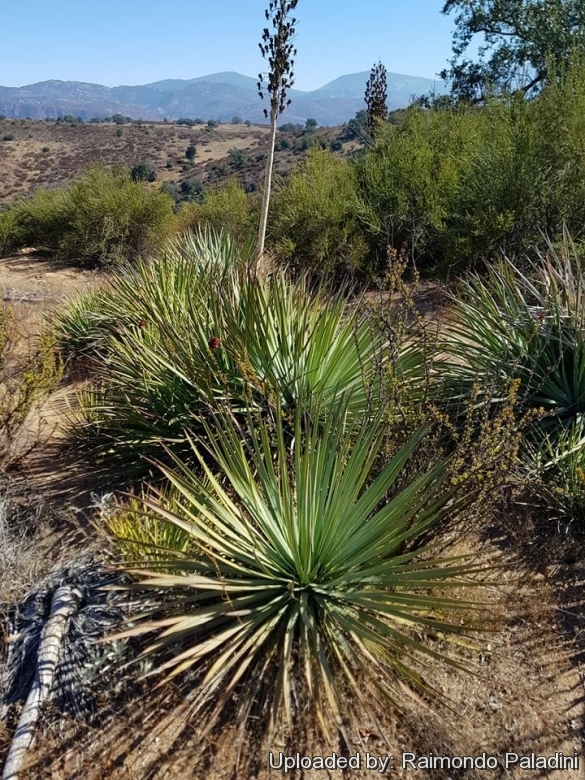
Yucca whipplei (Hesperoyucca whipplei) Photo by: Raimondo Paladini
Growing habit. San Diego Country Estates, California.
Origin and Habitat: Hesperoyucca whippleiSN|23297]]SN|23297]] occurs in Western North America
Altitude range: 300-2500 metres above sea level.
Habitat and ecology: This plant is primarily a chaparral species of the Californias, with a few desert populations in the Lower Colorado River Valley and gulf side of the Baja California peninsula. H. whipplei flowers in spring from February to June
Synonyms:
See all synonyms of Hesperoyucca whipplei
back
Accepted name in llifle Database:Hesperoyucca whipplei (Torr.) Baker ex Trel.Rep. (Annual) Missouri Bot. Gard. 4: 208 (tt. 16, 23). 1893 [9 Mar 1893]Synonymy: 36
back
Common Names include:
ENGLISH: Foothill Yucca, Chaparral Yucca, Our Lord's Candle, Spanish Bayonet, Quixote Yucca, Common Yucca, Candles of the Lord
SPANISH (Español): Quiote, Lechuguilla, Yucca
Description: HesperoSN'> 23321' alt='23305'>Yucca newberryi#SN#23323'>Hespero[[Yucca newberryiSN' style='border:none;'>SN|23297]] is a characteristics plant of the sunbaked mountain slopes of southern California and commonly known as the Spanish Bayonet or Our Lord's candle. It forms a stemless rosette of long, bluish-green, dagger-like leaves which end in a sharp point. The plant are monocarpic (reach maturity and flower, at which point it usually dies) or polycarpic, sometimes rhizomatous, some with secondary rosettes at base or stems branching to form new rosettes after flowering. The plant takes 5 or more years to reach maturity and flower at this point it sends up a blossom stalk that grows extremely fast and reaches about five metres in height. Its lovely, pendulous, creamy-white flowers are 5 cm across. These open in a clustered mass about 1 metre long. Its immense flower stalk, with thick base and numerous flowers, undoubtedly captures the attention of the peoples. The fruit is a dry winged capsule, which splits open at maturity to release the seeds. This species is highly variable.
23321' alt='23305'>Yucca newberryi#SN#23323'>Hespero[[Yucca newberryiSN' style='border:none;'>SN|23297]] is a characteristics plant of the sunbaked mountain slopes of southern California and commonly known as the Spanish Bayonet or Our Lord's candle. It forms a stemless rosette of long, bluish-green, dagger-like leaves which end in a sharp point. The plant are monocarpic (reach maturity and flower, at which point it usually dies) or polycarpic, sometimes rhizomatous, some with secondary rosettes at base or stems branching to form new rosettes after flowering. The plant takes 5 or more years to reach maturity and flower at this point it sends up a blossom stalk that grows extremely fast and reaches about five metres in height. Its lovely, pendulous, creamy-white flowers are 5 cm across. These open in a clustered mass about 1 metre long. Its immense flower stalk, with thick base and numerous flowers, undoubtedly captures the attention of the peoples. The fruit is a dry winged capsule, which splits open at maturity to release the seeds. This species is highly variable.
Rosettes: Single or cespitose, small to very large, sessile, sometimes stem rhizomatous, .
Leaves: Linear or rarely narrowly lanceolate, rigid and sword-like to flexible and frequently falcate, planoconvex or subtriquetrous, or keeled on both faces, 20-90 cm (rarely to 125 cm) long 0.5–2(-2.5) cm wide, green to grey-green, finely stripped, base expanded, 4-7 x 4-7 cm wide, white to greenish, margin thin, horny, without fibres and finely saw-toothed. End-spines sharp.
Inflorescences: A dense, terminal, branched, cylindrical or somewhat slenderly ellipsoidal panicle 25-280 cm long, 15–70 cm at widest point, bearing hundreds of flowers, covering the upper half of the inflorescence. Scape bracteate 0.9–3 m tall 2.5–15 cm in diameter near base.
Flowers: Hundreds, densely arranged, creamy-white (tinged with purple in some populations), usually broadly expanding, pendent, globose, 3.5-5 cm, very fragrant. Tepals 30-65 x 8-25 mm, white, tips generally purple, tube none. Filaments straight attached to the lower part of the tepals, so that they are pulled away from the ovary as the flower opena. Style short, slender distinctly capitate, green towards center.
Fruit (capsules): Obovoid, with conspicuous placental wings at maturity strictly loculicidally dehiscent, 3-5 cm long.
Seeds: Flat, thin, smooth, without marginal wing, 6 - 7 x 8 mm, dull black.
Chromosome number: n = 30.
Taxonomic notes: HesperoSN'> 23297' alt='23305'>Yucca whipplei#SN#23305'>Hespero[[Yucca whippleiSN' style='border:none;'>SN|23297]] has been treated as Yucca whipplei by most authors. It is distinguished from yuccas by its bright green, capitate stigma; capsules that dehisce between the septae; a tendency toward monocarpy (it flowers once, then dies) as do agaves; and self-incompatibility. Molecular analyses support a closer association with Hesperaloe, rather than Yucca. Hesperoyucca also differs from Yucca in forming a definite bulb in the seedling stage The plant treated as the subspecies Yucca whippleiSN|23305]]SN|23305]] subsp. newberryi has been shown to be genetically distinct, and is often treated as a distinct species, HesperoSN'>
23297' alt='23305'>Yucca whipplei#SN#23305'>Hespero[[Yucca whippleiSN' style='border:none;'>SN|23297]] has been treated as Yucca whipplei by most authors. It is distinguished from yuccas by its bright green, capitate stigma; capsules that dehisce between the septae; a tendency toward monocarpy (it flowers once, then dies) as do agaves; and self-incompatibility. Molecular analyses support a closer association with Hesperaloe, rather than Yucca. Hesperoyucca also differs from Yucca in forming a definite bulb in the seedling stage The plant treated as the subspecies Yucca whippleiSN|23305]]SN|23305]] subsp. newberryi has been shown to be genetically distinct, and is often treated as a distinct species, HesperoSN'> 23297' alt='23323'>Yucca whipplei#SN#23305'>Hespero[[Yucca whippleiSN' style='border:none;'>SN|23321]].
23297' alt='23323'>Yucca whipplei#SN#23305'>Hespero[[Yucca whippleiSN' style='border:none;'>SN|23321]].
Bibliography: Major references and further lectures
1) Urs Eggli, Illustrated Handbook of Succulent Plants: Monocotyledons, Springer Science & Business Media, 6 Dicembre 2012
2) Wendy C. Hodgson, "Food Plants of the Sonoran Desert" University of Arizona Press, 2001
3) Arizona-Sonora Desert Mus, "A Natural History of the Sonoran Desert", Revised and Updated Edition, University of California Press, 2000
4) Haines, A. L. 1941. "Variation in Yucca whipplei". Madrono 6: 33–45.
5) Hesperoyucca whipplei in Flora of North America @ efloras.org FNA Vol. 26 Page 439, 440 retrieved 10 December 2017 from <http://www.efloras.org/florataxon.aspx?flora_id=1&taxon_id=242101658>
6) Wikipedia contributors. "Hesperoyucca whipplei." Wikipedia, The Free Encyclopedia. Wikipedia, The Free Encyclopedia, 3 Nov. 2017. Web. 16 Dec. 2017.
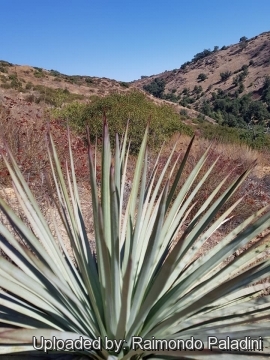 Hesperoyucca whipplei, San Diego Country Estates, California. (Hesperoyucca whipplei) Photo by: Raimondo Paladini
Hesperoyucca whipplei, San Diego Country Estates, California. (Hesperoyucca whipplei) Photo by: Raimondo Paladini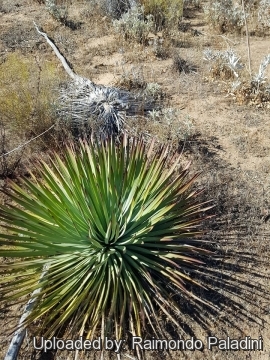 Hesperoyucca whipplei, San Diego Country Estates, California. (Hesperoyucca whipplei) Photo by: Raimondo Paladini
Hesperoyucca whipplei, San Diego Country Estates, California. (Hesperoyucca whipplei) Photo by: Raimondo Paladini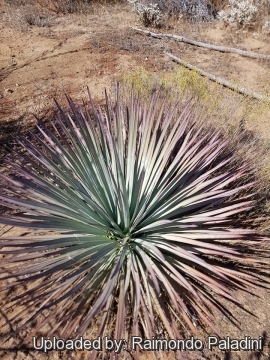 Hesperoyucca whipplei, San Diego Country Estates, California. (Hesperoyucca whipplei) Photo by: Raimondo Paladini
Hesperoyucca whipplei, San Diego Country Estates, California. (Hesperoyucca whipplei) Photo by: Raimondo Paladini Hesperoyucca whipplei, mature capsules. (Hesperoyucca whipplei) Photo by: Raimondo Paladini
Hesperoyucca whipplei, mature capsules. (Hesperoyucca whipplei) Photo by: Raimondo Paladini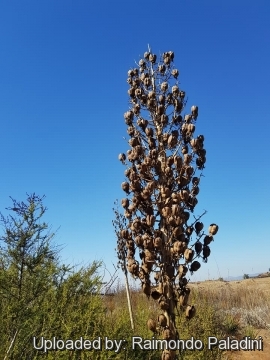 Hesperoyucca whipplei, mature capsules. (Hesperoyucca whipplei) Photo by: Raimondo Paladini
Hesperoyucca whipplei, mature capsules. (Hesperoyucca whipplei) Photo by: Raimondo Paladini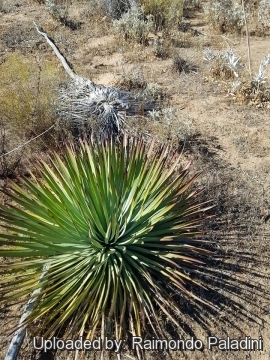 Hesperoyucca whipplei, San Diego Country Estates, California. (Hesperoyucca whipplei) Photo by: Raimondo Paladini
Hesperoyucca whipplei, San Diego Country Estates, California. (Hesperoyucca whipplei) Photo by: Raimondo Paladini Hesperoyucca whipplei, San Diego Country Estates, California. (Hesperoyucca whipplei) Photo by: Raimondo Paladini
Hesperoyucca whipplei, San Diego Country Estates, California. (Hesperoyucca whipplei) Photo by: Raimondo Paladini Hesperoyucca whipplei, San Diego Country Estates, California. (Hesperoyucca whipplei) Photo by: Raimondo Paladini
Hesperoyucca whipplei, San Diego Country Estates, California. (Hesperoyucca whipplei) Photo by: Raimondo PaladiniCultivation and Propagation: Most subspecies produce offshoots from the base, so that although the parent plant flowers and dies, a cluster of clones around its base continue to grow and reproduce. It may also grow back from its base after much of its foliage has been scorched off by the wildfires that frequent its range.


















